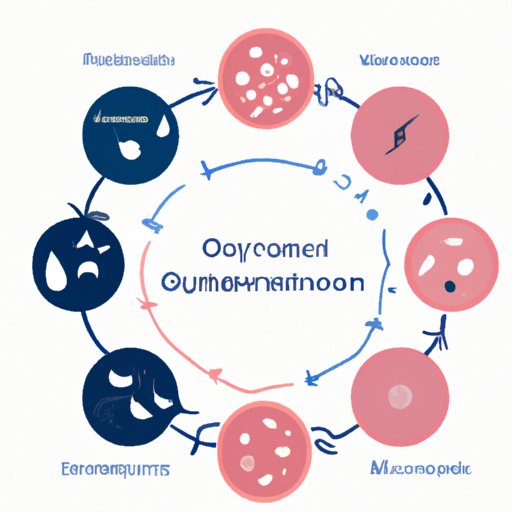
Introduction
For many women, identifying ovulation can be a daunting task, especially if they are trying to conceive. However, knowing when ovulation occurs is crucial for fertility. In this article, we will explore the signs of ovulation, the biology of ovulation, how to track your menstrual cycle, and common myths about ovulation.
7 Signs That Indicate You’re Ovulating: A Comprehensive Guide
There are seven signs that indicate you are ovulating. These include cervical mucus changes, basal body temperature shifts, ovulation pain, breast tenderness, increased sex drive, spotting, and positive ovulation test results. Understanding each sign can help you track your ovulation and increase your chances of becoming pregnant.
Cervical Mucus Changes: Before ovulation occurs, the cervical mucus becomes thinner and more slippery to allow sperm to travel through the cervix.
Basal Body Temperature Shifts: Basal body temperature rises after ovulation due to the release of the hormone progesterone. Tracking your basal body temperature can help you identify when ovulation has occurred.
Ovulation Pain: Some women experience mild cramping on one side of their abdomen during ovulation.
Breast Tenderness: Hormonal changes during ovulation can cause breast tenderness.
Increased Sex Drive: Women may feel more sexually attracted to their partners during ovulation due to hormonal changes.
Spotting: Some women experience light spotting during ovulation.
Positive Ovulation Test Results: Over-the-counter ovulation predictor kits can detect the hormone surge that triggers ovulation.
The Biology of Ovulation: How Your Body Signals Fertility
Understanding female reproductive anatomy and hormonal changes during ovulation can help you prepare your body for conception.
Female Reproductive Anatomy: The female reproductive system consists of the ovaries, fallopian tubes, uterus, cervix, and vagina. Each month, an ovary releases an egg that travels through the fallopian tube towards the uterus.
Hormonal Changes During Ovulation: Estrogen levels rise during the first half of the menstrual cycle, causing the uterine lining to thicken. Progesterone levels rise after ovulation, preparing the uterus for implantation.
How These Changes Make the Body Ready for Conception: These hormonal changes create the ideal environment for sperm to fertilize an egg and the fertilized egg to implant in the uterus, resulting in pregnancy.
Tracking Your Menstrual Cycle: How to Pinpoint Your Ovulation with Accuracy
Tracking your menstrual cycle can help you pinpoint your ovulation with accuracy.
Menstrual Cycle Phases: The menstrual cycle consists of four phases: the menstrual phase, follicular phase, ovulatory phase, and luteal phase.
Methods to Track Menstrual Cycle: You can track your menstrual cycle using the calendar method, temperature method, and ovulation predictor kits.
Importance of Tracking Menstrual Cycle: Tracking your menstrual cycle can help you identify patterns and predict when ovulation will occur.

The Role of Hormones in Ovulation: Understanding the Interplay Between Estrogen and Progesterone
Estrogen and progesterone hormones play a key role in ovulation.
Explanation of Estrogen and Progesterone Hormones: Estrogen and progesterone are two female sex hormones that regulate the menstrual cycle and prepare the body for pregnancy.
How They Affect Ovulation: Estrogen levels rise during the first half of the menstrual cycle, causing the uterine lining to thicken. Progesterone levels rise after ovulation, preparing the uterus for implantation.
The Role of Luteinizing Hormone (LH) in Ovulation: The luteinizing hormone (LH) triggers ovulation by causing the mature egg to be released from the ovary.
Ovulation Testing 101: Different Methods to Detect Ovulation
There are three different types of ovulation tests: urine-based tests, saliva-based tests, and blood tests.
Overview of Ovulation Testing: Ovulation testing can help you detect when ovulation will occur.
Types of Ovulation Tests: Urine-based tests detect the LH surge, saliva-based tests detect hormonal changes in saliva, and blood tests detect changes in hormone levels.
How to Use Ovulation Tests: Follow the instructions on the ovulation test kit carefully, and use the test at the same time each day during your fertile window.
How to Boost Your Chances of Conception: Timing Intercourse During Ovulation
Timing intercourse during the fertile window can increase your chances of becoming pregnant.
Explanation of Fertile Window: The fertile window is the period in which intercourse can result in pregnancy. It typically lasts from five days before ovulation to the day of ovulation.
Importance of Timing Intercourse During Ovulation: Having intercourse during your fertile window maximizes your chances of becoming pregnant.
Tips for Maximizing Chances of Conception: Have intercourse every two to three days during your fertile window, don’t use lubricants that can hinder sperm movement, and stay lying down for at least fifteen minutes after intercourse.
Common Myths and Misconceptions About Ovulation: Setting the Record Straight
There are several common myths and misconceptions about ovulation.
Overview of Common Myths About Ovulation: Some of the myths include women ovulating on the same day every month, ovulation only occurring on day fourteen of the menstrual cycle, and ovulation only occurring once a month.
Explanation of the Truth Behind Each Myth: Ovulation can occur on different days of the menstrual cycle, ovulation patterns can vary from month to month, and some women ovulate more than once a month.
Importance of Understanding the Facts About Ovulation: Understanding the facts about ovulation can help women increase their chances of becoming pregnant and avoid common misconceptions.
Conclusion
Knowing how to identify ovulation is crucial for fertility. Understanding the signs of ovulation, the biology of ovulation, how to track your menstrual cycle, the role of hormones in ovulation, ovulation testing, timing intercourse during ovulation, and common myths about ovulation can all help women increase their chances of becoming pregnant. Remember to consult with your healthcare provider for any questions or concerns about your fertility.
Final Thoughts and Advice: Keep in mind that getting pregnant can take time and that stress can negatively affect fertility. Take care of your physical and emotional health, and be patient with the process.




